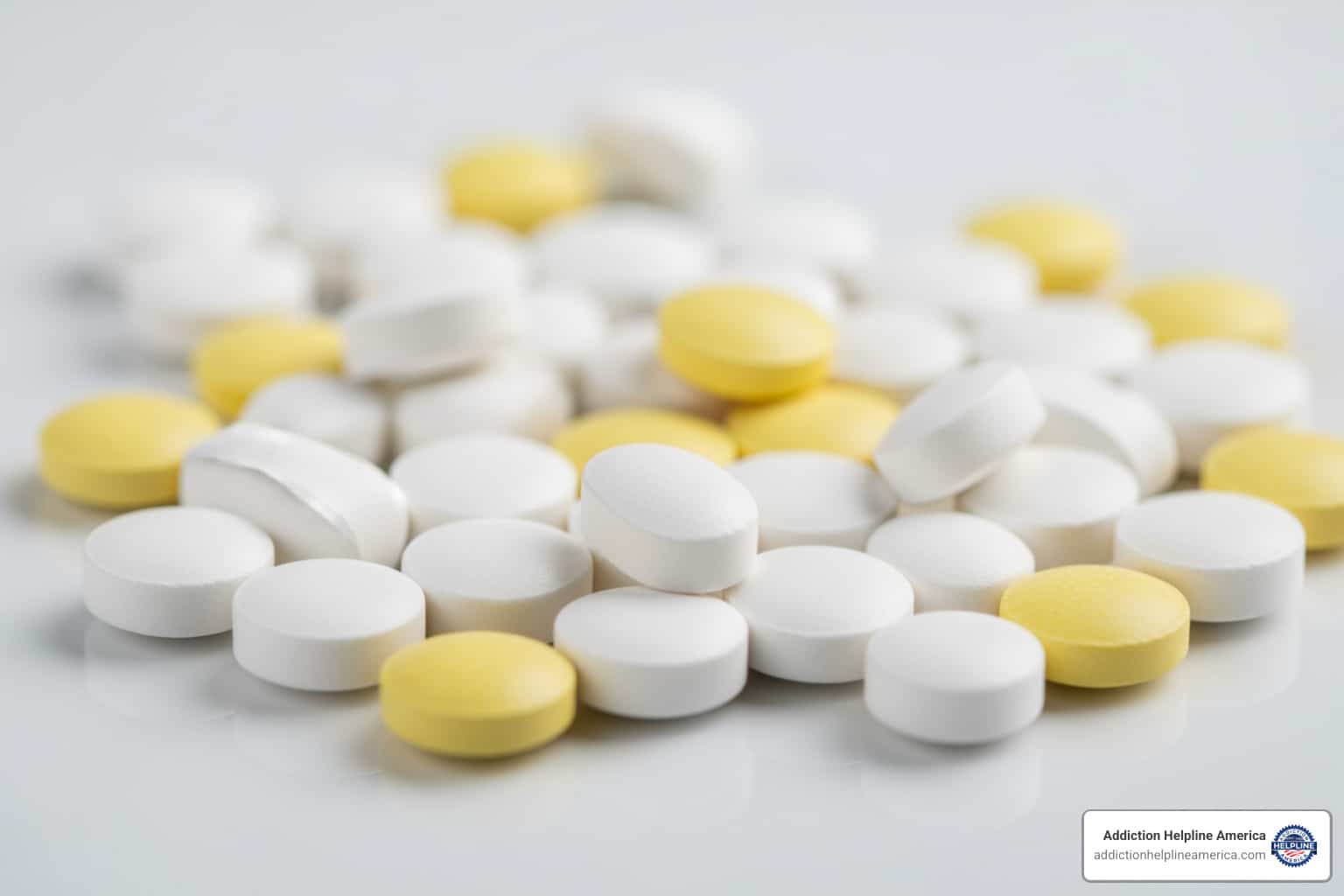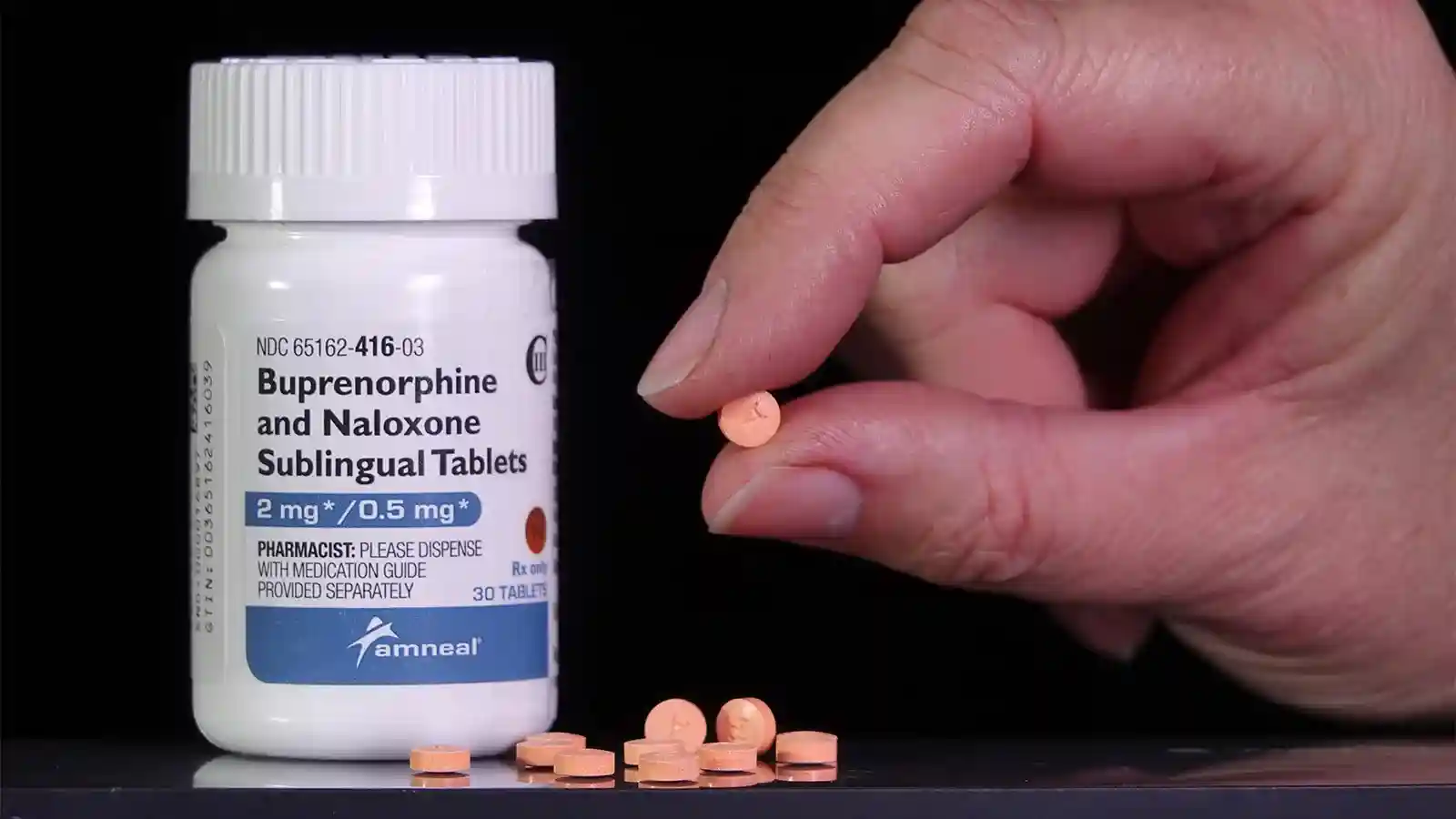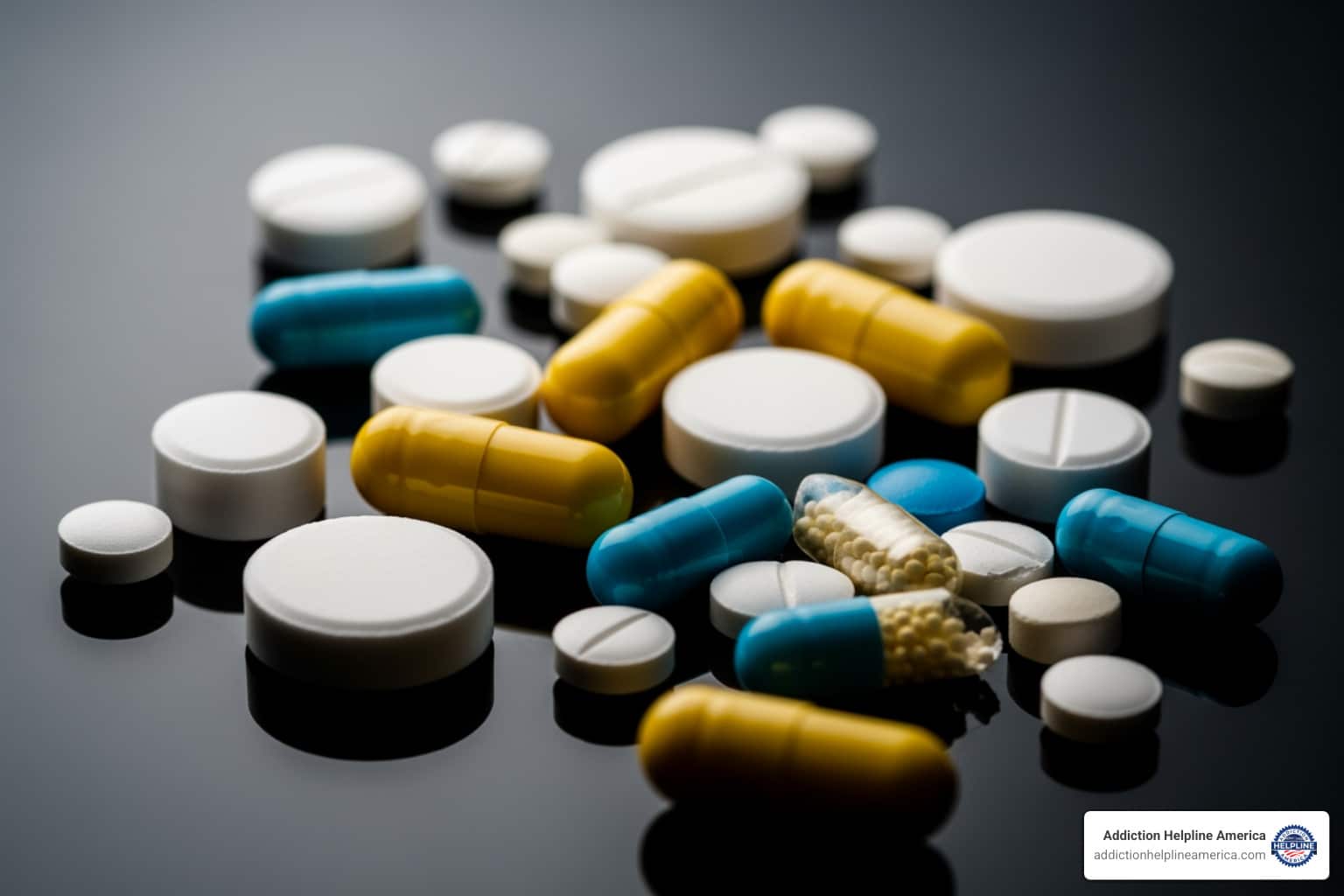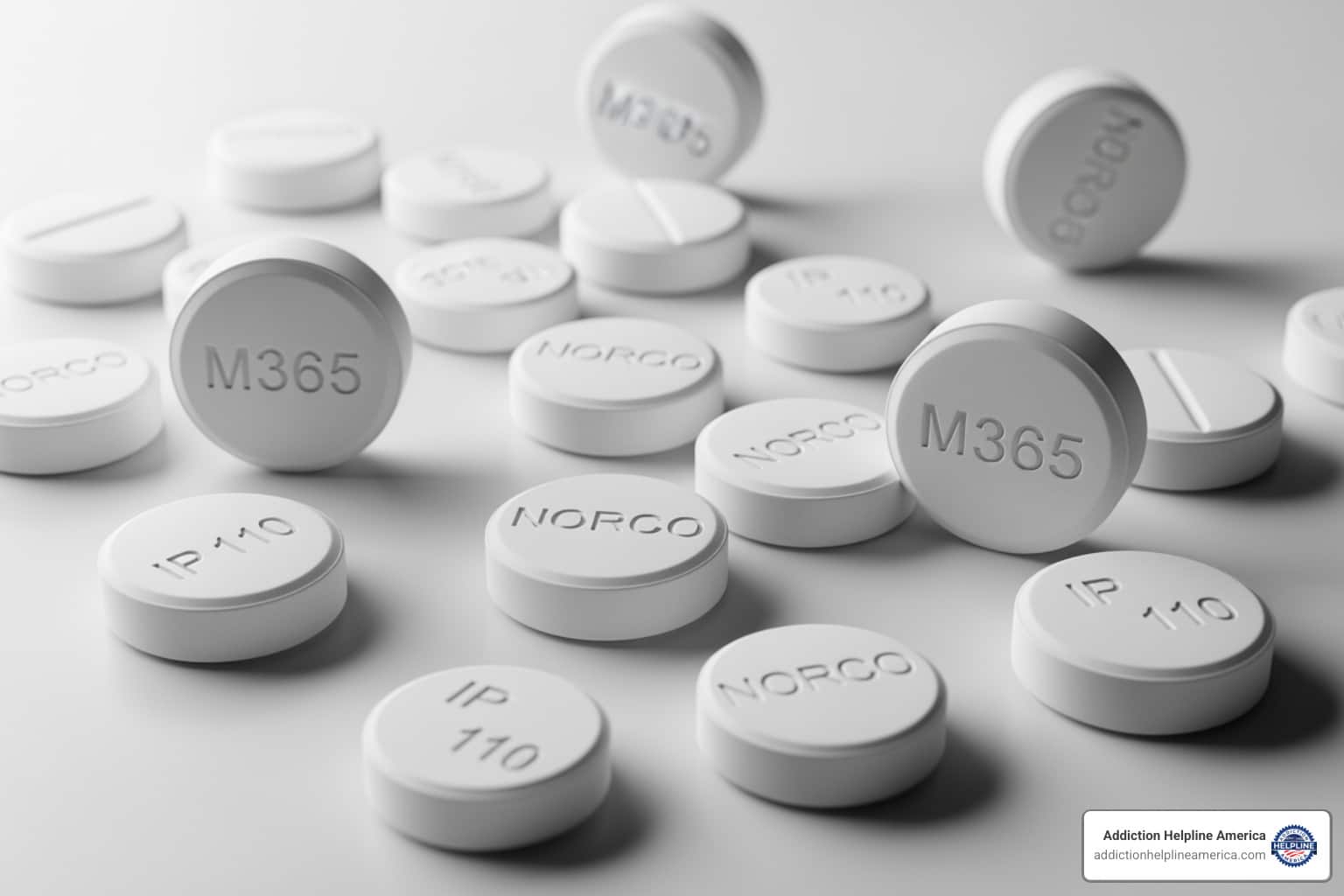
Understanding Percocets: What You Need to Know
Percocets are prescription pain medications combining oxycodone and acetaminophen. Here’s a quick overview:
- What it is: A Schedule II controlled substance for moderate to severe pain.
- Active ingredients: Oxycodone (an opioid) and Acetaminophen (a pain reliever).
- How it works: The oxycodone blocks pain signals and releases dopamine, causing euphoria. The acetaminophen adds further pain relief.
- Key risks: High potential for addiction, dependence, liver damage, and overdose.
- Common strengths: Available in 2.5mg/325mg, 5mg/325mg, 7.5mg/325mg, and 10mg/325mg tablets.
While effective for pain, Percocet carries serious risks. More than 2 million people in the U.S. misused oxycodone products like Percocet last year. The oxycodone component drives the high addiction potential, while the acetaminophen can cause acute liver failure in high doses (over 4,000 mg per day).
Mixing Percocet with alcohol or other depressants can slow breathing to fatal levels. Withdrawal symptoms are severe, making it difficult to quit without medical support.
At Addiction Helpline America, we guide individuals and families through the challenges of Percocet addiction. We provide compassionate, 24/7 support, connecting people with evidence-based treatment to find their path to recovery.
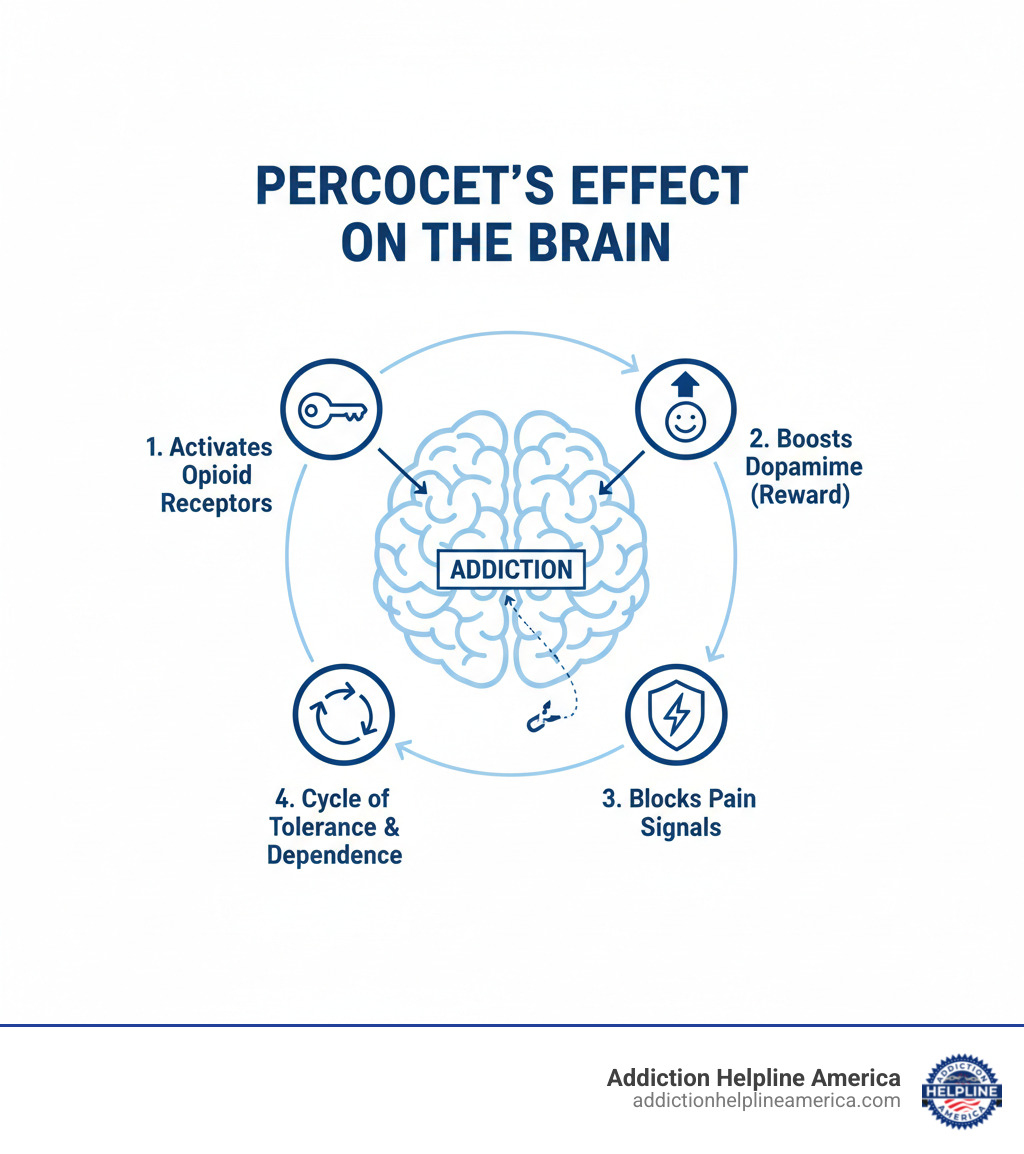
What is Percocet and How Does It Work?
Percocet is a powerful prescription pain reliever for moderate to severe pain, but its strength comes with serious risks of dependence and addiction. Understanding how it works is key to using it safely.
When taken, Percocet’s oxycodone component travels to the brain and spinal cord, binding to opioid receptors. This action blocks pain signals and triggers a release of dopamine, a chemical that causes feelings of euphoria and relaxation. This dopamine rush is why Percocets have a high potential for misuse, as the brain begins to crave that feeling even after the pain subsides.
The term “opioid” includes natural substances from the opium poppy (opiates like morphine), semi-synthetic versions like the oxycodone in Percocet, and fully synthetic ones like fentanyl. For a deeper look at opioid pharmacology, this Basic opioid pharmacology: an update offers valuable insights. Compared to similar drugs, Percocet is stronger than codeine-based medications but generally less potent than extended-release drugs like OxyContin.
Primary Active Ingredients
Percocet contains two active ingredients that work together:
- Oxycodone: This semi-synthetic opioid provides the primary pain relief and euphoric effects. The DEA classifies it as a Schedule II controlled substance due to its high potential for abuse and severe dependence.
- Acetaminophen: Commonly known as Tylenol, this non-opioid pain reliever improves oxycodone’s effects. However, taking too much acetaminophen (often by combining Percocet with other Tylenol products) can cause severe liver damage.
Medical Uses for Percocet
Doctors prescribe Percocet when other pain treatments are insufficient. Common uses include short-term relief for post-surgical pain or acute injury pain from events like broken bones or severe burns. While it can be used for chronic pain management, this is less common today due to the known risks of long-term opioid use. Such cases require extremely careful monitoring by a doctor to watch for signs of dependence.
If you’re concerned about Percocet dependence or misuse, help is available. Addiction Helpline America offers free, confidential connections to treatment options custom to your needs.
The Dangers and Risks of Taking Percocets
Even when taken as prescribed, Percocets carry significant dangers. The U.S. Drug Enforcement Administration classifies Percocet as a Schedule II controlled substance, highlighting its high potential for abuse alongside its medical uses. The same mechanism that relieves pain also triggers the brain’s reward system, creating a cycle of tolerance and craving that can be difficult to break. Physical dependence is a biological reality of long-term use, where the body adapts and experiences withdrawal without the drug.

If you’re concerned about your use, our Drug Detox Near Me Guide can help you find local support.
Short-Term and Long-Term Adverse Effects of Percocets Misuse
Misusing Percocets can cause immediate and long-term harm.
Short-term effects include dizziness, drowsiness, confusion, nausea, constipation, and itching. While some feel euphoria, others experience an unsettling sense of unease (dysphoria).
Long-term effects are more severe. The acetaminophen in Percocet can cause acute liver failure if you exceed 4,000 mg per day. Chronic misuse also leads to kidney problems, hormonal imbalances, and an increased risk of developing Opioid Use Disorder (opioid addiction). It can worsen depression and anxiety and, paradoxically, lead to opioid-induced hyperalgesia, a condition that makes you more sensitive to pain. If you’re dealing with depression and substance use, our Residential Rehab Depression Complete Guide offers helpful insights.
Dangers of Mixing Percocet with Other Substances
Combining Percocets with other substances is extremely dangerous. Alcohol, benzodiazepines (like Xanax), and other sedatives are all central nervous system depressants. Mixing them multiplies their effects, leading to profound sedation, respiratory depression (slowed or stopped breathing), coma, and death.
Illicitly purchased pills sold as Percocet are often counterfeit and may contain fentanyl, a synthetic opioid 50-100 times more potent than morphine. A single pill can be lethal.
Symptoms of a Percocets Overdose
Recognizing an overdose is critical. Call 911 immediately if you see these signs:
- Extremely slow, shallow, or stopped breathing (respiratory depression)
- Unconsciousness or inability to wake up
- Pinpoint pupils
- Blue or purplish lips and fingernails
- Cold, clammy skin
- Limp body, choking, or gurgling sounds
If available, administer naloxone (Narcan), a medication that can temporarily reverse an opioid overdose. Keep the person awake and breathing until help arrives. The CDC offers guidance on recognizing signs of an overdose. At Addiction Helpline America, we provide 24/7 confidential support for these frightening situations.
Recognizing and Understanding Percocet Addiction
Percocet addiction is a medical condition that changes brain function, driving compulsive drug use despite negative consequences. It is a disease that requires professional treatment, not a failure of willpower.

Misuse often begins with behaviors like “doctor shopping” for multiple prescriptions or taking more pills than prescribed to chase a euphoric feeling. Risk factors for addiction include a family history of substance abuse, co-occurring mental health conditions like depression or anxiety, and a history of trauma. The longer and higher the dose, the greater the risk.
If you need help, our More info about Substance Abuse Treatment Helpline Guide connects you with caring professionals.
Signs of Percocet Misuse and Addiction
Recognizing when use has become an addiction involves observing key changes:
- Behavioral Signs: Withdrawing from family and friends, losing interest in hobbies, unexplained financial problems, neglecting responsibilities, and secrecy about pill use.
- Psychological Signs: Intense cravings, mood swings (irritability, anxiety, depression), and being unable to cut back or quit despite wanting to.
- Physical Signs: Changes in appearance, constricted (pinpoint) pupils, frequent drowsiness or “nodding off,” and recurring flu-like symptoms, which are actually signs of withdrawal.
A key indicator is continued use despite obvious harm to one’s health, relationships, or legal standing.
Percocet Withdrawal and Detoxification
When a dependent person stops using Percocets, they experience withdrawal. Symptoms can be severe and include intense anxiety, muscle and bone aches, nausea, vomiting, diarrhea, insomnia, sweating, and chills. These symptoms typically peak 24-72 hours after the last dose and can make quitting alone feel impossible.
Medically supervised detox is the safest and most effective way to manage withdrawal. In a professional setting, healthcare providers use medications to ease symptoms and reduce cravings, making the process more manageable and increasing the chances of a successful recovery. For more on this process, our guide on More info about Detox for Cocaine provides helpful information applicable to opioids like Percocet.
Percocet’s Role in the Opioid Crisis
The current opioid crisis unfolded in three waves, and prescription medications like Percocet played a key role in the beginning.
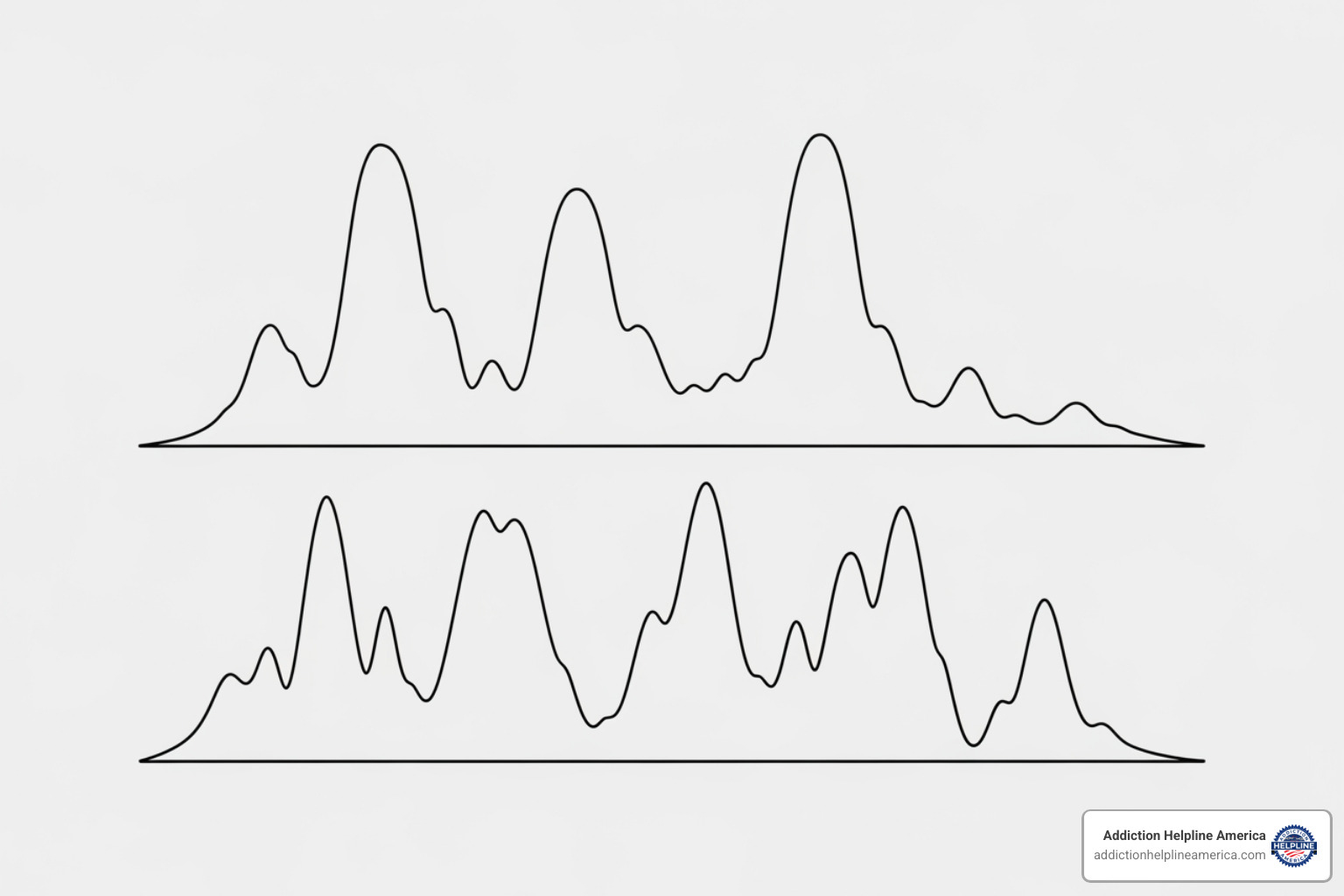
The first wave began in the 1990s with the over-prescription of opioids. Misleading marketing from pharmaceutical companies led to widespread prescribing, creating a generation of patients who became physically dependent.
The second wave started around 2010, as people who could no longer get prescriptions turned to heroin, a cheaper and more accessible street opioid.
The third wave, beginning around 2013, saw the rise of illicitly manufactured fentanyl, a synthetic opioid 50-100 times stronger than morphine. It’s often mixed into counterfeit pills made to look exactly like Percocet, leading to a surge in accidental overdose deaths.
Percocet and the Broader Opioid Epidemic
The over-prescription of Percocet and similar drugs for everything from minor surgery to back injuries created a large population vulnerable to addiction. When prescriptions ran out, the addiction remained, pushing many toward the illicit market. Today, the greatest danger is counterfeit pills containing fentanyl, where one pill can be fatal.
Legal Status and Societal Impact
Due to its high abuse potential, Percocet is a Schedule II controlled substance under strict DEA regulation. Many states use Prescription Drug Monitoring Programs (PDMPs) to track prescriptions and prevent “doctor shopping.” The societal impact has been devastating, straining families, overwhelming emergency rooms and foster care systems, and costing billions in healthcare and lost productivity. The stigma of addiction often prevents people from seeking help.
Behind every statistic is a person who deserves compassion. At Addiction Helpline America, we know recovery is possible and connect people with the treatment they need to rebuild their lives.
Finding Help and Treatment for Percocet Addiction
If you or a loved one is struggling with Percocet addiction, recovery is possible. Taking the first step is the hardest part, but a network of support is ready to help you heal. At Addiction Helpline America, our admissions navigators offer free, confidential guidance to connect you with the right treatment center for your unique situation. We simplify the process and walk with you every step of the way. Learn more with our guide on More info about How to Find a Good Rehab Center.

Available Treatment Options
Effective treatment for Percocet addiction combines several approaches:
- Medical Detox: A safe, supervised environment where professionals manage withdrawal symptoms with medications to make the process more comfortable.
- Inpatient/Residential Rehab: Provides 24/7 care and intensive therapy in a structured setting, away from daily triggers.
- Outpatient Programs (PHP/IOP): Offer flexible yet comprehensive treatment, allowing you to maintain work or family commitments while in recovery.
- Behavioral Therapies: Core to treatment, therapies like Cognitive Behavioral Therapy (CBT) teach coping skills, craving management, and relapse prevention strategies. Explore options in our guide to
More info about Therapeutic Approaches. - Medication-Assisted Treatment (MAT): The gold standard for opioid addiction, MAT combines medications (like buprenorphine or naltrexone) with counseling. These medications normalize brain chemistry, reduce cravings, and lower overdose risk.
Aftercare and Relapse Prevention
Recovery is a lifelong journey that continues after a formal program ends. Strong aftercare is crucial for long-term sobriety.
- Support Groups: Groups like Narcotics Anonymous (NA) provide invaluable peer support and a sense of community.
- Sober Living Homes: These transitional residences offer a safe, drug-free environment with structure and accountability.
- Ongoing Counseling: Continuing therapy helps address underlying issues and steer life’s challenges without returning to substance use.
- Building a Support Network: Connecting with sober friends, supportive family, and mentors creates a vital safety net.
We’re here to help you find the right treatment center. Recovery from Percocet addiction is possible, and you don’t have to do it alone. We’re just a phone call away.
Frequently Asked Questions about Percocet
Here are answers to some of the most common questions we receive about Percocets.
How long does Percocet stay in your system?
The detection window for oxycodone, the opioid in Percocet, varies by test type and individual factors like metabolism, dosage, and frequency of use.
- Urine tests: 1 to 4 days
- Saliva tests: 1 to 2 days
- Blood tests: Up to 24 hours
- Hair follicle tests: Up to 90 days
What is the difference between Percocet and OxyContin?
While both contain oxycodone, they have two key differences. First, Percocet combines oxycodone with acetaminophen, while OxyContin contains only oxycodone. This means Percocet carries an additional risk of liver damage from acetaminophen.
Second, their release mechanisms differ. Percocet is immediate-release, with effects lasting 4-6 hours, making it suitable for acute pain. OxyContin is controlled-release, providing pain relief for about 12 hours, which is better for chronic, around-the-clock pain.
Can you become addicted to Percocet if you take it as prescribed?
Yes, you absolutely can. Taking Percocet exactly as your doctor prescribes does not eliminate the risk of physical dependence and addiction. Physical dependence is a normal physiological adaptation where your body experiences withdrawal if you stop suddenly. Tolerance can also develop, meaning you need higher doses for the same effect.
Addiction is a brain disease characterized by compulsive drug use despite harmful consequences. Even with prescribed use, you might find yourself thinking about the medication constantly, escalating your dose, or feeling unable to stop. Factors like family history, mental health conditions, and the duration of use increase this risk. This is why close medical supervision is critical when taking any opioid medication.
If you’re concerned about your relationship with Percocet, even while taking it as prescribed, please reach out. Addiction Helpline America provides free, confidential guidance with no judgment.
Conclusion
Percocets are powerful medications that balance pain relief with significant risk. The oxycodone component effectively blocks pain but also drives a high potential for addiction, while the acetaminophen can cause liver damage in high doses. This class of drugs played a central role in sparking the opioid crisis, which continues to devastate communities with the spread of deadly fentanyl-laced counterfeit pills.
Recognizing the signs of misuse and understanding the dangers of withdrawal and overdose are critical. But the most important thing to remember is that addiction is a treatable medical condition, not a moral failing. Recovery is not just possible—it happens every day.
At Addiction Helpline America, our mission is to connect people with the care they need to heal. Our compassionate team is available 24/7 to offer free, confidential guidance, helping you steer treatment options to find a program that fits your unique situation. You don’t have to figure this out alone.
Find personalized Percocet addiction treatment today
Your journey toward healing starts with a single phone call. We’re ready when you are.
Our helpline is 100%
free & confidential
If you or someone you care about is struggling with drug or alcohol addiction, we can help you explore your recovery options. Don’t face this challenge alone—seek support from us.
Programs
Resources
Will my insurance
cover addiction
treatment?
We're ready to help
Find the best
drug or alcohol treatment
center
Are you or a loved one struggling with addiction? Call today to speak to a treatment expert.



